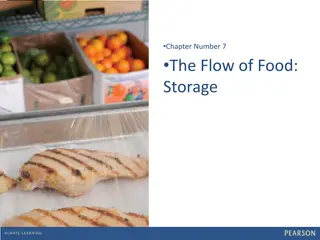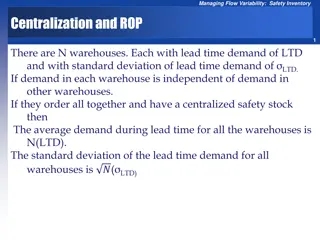
Understanding Stack Frames in Return Oriented Programming
Explore the concept of stack frames in Return Oriented Programming through illustrations and explanations. Learn about function calls, return addresses, stack overflow, and more.
Download Presentation

Please find below an Image/Link to download the presentation.
The content on the website is provided AS IS for your information and personal use only. It may not be sold, licensed, or shared on other websites without obtaining consent from the author. If you encounter any issues during the download, it is possible that the publisher has removed the file from their server.
You are allowed to download the files provided on this website for personal or commercial use, subject to the condition that they are used lawfully. All files are the property of their respective owners.
The content on the website is provided AS IS for your information and personal use only. It may not be sold, licensed, or shared on other websites without obtaining consent from the author.
E N D
Presentation Transcript
Return Oriented Programming Courtesy of Saumil Shah
Functions Revisited How is a function called? What does the stack frame look like?
Calling a function Add two ints x, y add(3,4) What does the calling frame look like? void add(int x, int y) { int sum; sum = x + y; printf("%d\n", sum); } int main() { add(3, 4); }
Stack frame for add(3,4) frame for add() return address from add() call add 3 4
Return from add(3,4) add() is about to return. RET after epilogue of add(). Where does ESP point to? immediately before the RET What does the stack look like?
Before the RET ESP return address from add() 3 4
After the RET return address from add() ESP 3 4
Another function Stack overflow in func1. Can we call add(5, 6), instead of running a shellcode? void add(int x, int y) { int sum; sum = x + y; printf("%d\n", sum); } void func1(char *s) { char buffer[128]; strcpy(buffer, s); } int main() { func1(argv[1]); }
Stack frame for func1() buffer return address from func1 s
strcpy(buffer , s) uffer AAAAAAAAAAAAAAAAAA AAAAAAAAAAAAAAAAAA AAAAAAAAAAAAAAAAAA AAAAAAAAAAAAAAAAAA return address from func1 AAAA AAAA s AAAA AAAA
Before the RET uffer AAAAAAAAAAAAAAAAAA AAAAAAAAAAAAAAAAAA AAAAAAAAAAAAAAAAAA AAAAAAAAAAAAAAAAAA ESP return address from func1 AAAA AAAA s AAAA AAAA
After the RET uffer AAAAAAAAAAAAAAAAAA AAAAAAAAAAAAAAAAAA AAAAAAAAAAAAAAAAAA AAAAAAAAAAAAAAAAAA return address from func1 AAAA EIP = 0x41414141 ESP AAAA s AAAA AAAA
Return to add() Insert a fake frame in the buffer . Make func1() return to: add(01010101, 02020202)
strcpy(buffer , s) uffer AAAAAAAAAAAAAAAAAA AAAAAAAAAAAAAAAAAA AAAAAAAAAAAAAAAAAA AAAAAAAAAAAAAAAAAA return address from func1 address of add() return address from add() s 01010101 02020202
Before func1() returns uffer AAAAAAAAAAAAAAAAAA AAAAAAAAAAAAAAAAAA AAAAAAAAAAAAAAAAAA AAAAAAAAAAAAAAAAAA ESP return address from func1 address of add() return address from add() s 01010101 02020202
Before add() returns uffer AAAAAAAAAAAAAAAAAA AAAAAAAAAAAAAAAAAA AAAAAAAAAAAAAAAAAA AAAAAAAAAAAAAAAAAA return address from func1 address of add() ESP return address from add() s 01010101 02020202
Return to add() By carefully creating a frame... ...we can make the program "return to our We We our function returns. function". control the parameters. also control where to jump to after
Stack frame before add(3, 4) Dump the stack: (gdb) x/10x $esp 0xbffff41c: 0x08048471 0x00000003 0x00000004 0x0804851b 0xbffff42c: 0x00292ff4 0x08048510 0x00000000 0xbffff4b8 return address from add() 0x08048471 3 4 param1 param2
Overflowing func1() Overflow func1 and... ...return to add(01010101, Create a fake frame. Overwrite stack memory . 02020202) return from func1 return from add param1 param2 0x080484bd 0x42424242 0x01010101 0x02020202
ESP Where will ESP be after add? returning from AAAAAA...140...AAAAAA 080484bd 42424242 01010101 02020202 ESP Verify (gdb) x/64x $esp 0xbffff2e4: 0x01010101 0x02020202 0x00292f00 0x08048510 0xbffff2f4: 0x00000000 0xbffff378 0x00153bd6 0x00000002
Chaining functions After add(01010101, 02020202), we want to run add(03030303, 04040404). How should we set up the frames? First, study the frame after add() returns.
Where does the new frame go? AAAAAAAAAAAAAAAAAAAA AAAAAAAAAAAAAAAAAAAA AAAAAAAAAAAAAAAAAAAA address of add 42424242 address of add 01010101 ?? 02020202 03030303 04040404
Where does the new frame go? We get only ONE chance at strcpy . How do we preserve params 01010101 and 02020202? We can onlyAPPEND the second frame below our first frame. We have to unwind the first frame before returning to the second frame. Answer: Return to pop pop ret !
Chaining the frames AAAAAAAAAAAAAAAAAAAAAAAAAAAAAAA AAAAAAAAAAAAAAAAAAAAAAAAAAAAAAA AAAAAAAAAAAAAAAAAAAAAAAAAAAAAAA add(01010101, 02020202) address of add address of POP/POP/RET 01010101 02020202 add(03030303, 04040404) address of add 42424242 03030303 04040404
Keeping ESP in control AAAAAAAAAAAAAAAAAAAAAAAAAAAAAAA AAAAAAAAAAAAAAAAAAAAAAAAAAAAAAA AAAAAAAAAAAAAAAAAAAAAAAAAAAAAAA Return from func1 ESP address of add address of POP/POP/RET 01010101 02020202 address of add 42424242 03030303 04040404
Keeping ESP in control AAAAAAAAAAAAAAAAAAAAAAAAAAAAAAA AAAAAAAAAAAAAAAAAAAAAAAAAAAAAAA AAAAAAAAAAAAAAAAAAAAAAAAAAAAAAA Return from func1 address of add Return to add() ESP address of POP/POP/RET 01010101 02020202 address of add 42424242 03030303 04040404
Keeping ESP in control AAAAAAAAAAAAAAAAAAAAAAAAAAAAAAA AAAAAAAAAAAAAAAAAAAAAAAAAAAAAAA AAAAAAAAAAAAAAAAAAAAAAAAAAAAAAA Return from func1 address of add Return to add() address of POP/POP/RET Return to POP/POP/RET ESP 01010101 02020202 address of add 42424242 03030303 04040404
Keeping ESP in control AAAAAAAAAAAAAAAAAAAAAAAAAAAAAAA AAAAAAAAAAAAAAAAAAAAAAAAAAAAAAA AAAAAAAAAAAAAAAAAAAAAAAAAAAAAAA Return from func1 address of add Return to add() address of POP/POP/RET Return to POP/POP/RET 01010101 POP 02020202 POP ESP address of add 42424242 03030303 04040404
Keeping ESP in control AAAAAAAAAAAAAAAAAAAAAAAAAAAAAAA AAAAAAAAAAAAAAAAAAAAAAAAAAAAAAA AAAAAAAAAAAAAAAAAAAAAAAAAAAAAAA Return from func1 address of add Return to add() address of POP/POP/RET Return to POP/POP/RET 01010101 POP 02020202 POP address of add RET - Return to add() ESP 42424242 03030303 04040404
Keeping ESP in control AAAAAAAAAAAAAAAAAAAAAAAAAAAAAAA AAAAAAAAAAAAAAAAAAAAAAAAAAAAAAA AAAAAAAAAAAAAAAAAAAAAAAAAAAAAAA Return from func1 address of add Return to add() address of POP/POP/RET Return to POP/POP/RET 01010101 POP 02020202 POP address of add RET - Return to add() 42424242 Finally EIP = 0x42424242 ESP 03030303 04040404
Chained Frames Create another buffer overflow payload: AAAAAA...140...AAAAAA 080484bd 08048422 01010101 02020202 distance to EIP address of add POP/POP /RET param1 param2 080484bd 42424242 03030303 04040404 address of add return from add param1 param2
It's all about ESP! ESP is the new EIP . ROP involves keeping the ESP moving through the frames on the stack. Frames can be chained by returning to proper sequences of instructions that appropriately unwind the parameters from the stack.
Code Execution The ROP Way Piece together snippets of code Gadgets primitive operations, to be searched for within the process binary shared libraries. or Every gadget must end with a RET .
binobj1 f2() f1() f3() A RET RET Execute A, take next card D RET Execute D, take next card binobj2 Execute C, take next card f5 () f4() C RET Execute B, take next card RET binobj3 Execute D, take next card f7 () f8() f6() Execute E, take next card B E RET RET RET
Thinking in ROP terms POP EAX; RET 14 EAX = 0x14 Load immediate POP EAX; RET ECX = [77ffe0300] 77ffe0300 MOV ECX, [EAX]; RET Read memory POP EAX; RET [08041000] = 0x4000 08041000 POP ECX; RET 4000 MOV [EAX], ECX; RET Write memory
Thinking in ROP terms func1 func1(10, 20) POP/POP/RET 10 20 Call function
Thinking in ROP terms POP EAX; RET fptr CALL DWORD PTR [EAX]; RET (*fptr)(3, 4) 10 Call function pointer 20 POP EAX; RET fptr MOV EAX, [EAX]; RET CALL EAX; RET 10 20
Gadgets ROP primitives. Each gadget corresponds to a frame that must be set up on the stack Must end with a RET!
Generic Techniques Run arbitrary shellcode. Difficult to transform entire shellcode to ROP frames. Common trick: Use ROP to change protection of existing memory to RWX Works when shellcode is at a predictable location.
Case Study JNLP overflow on IE8, Windows 7 Java Network Launch Protocol enables applications to be launched on a client desktop that using resources which are hosted on a remote server. JNLP plug-in for Internet Explorer has a buffer overflow vulnerability Extra long docbase parameter passed to JNLP.
What is a browser? More Attack Surface!
Browser Architecture <div> <img> <object> <embed> <iframe> <body> <form> <input> <table> <style> <script> JavaScript HTML+CSS DOM Mime types ActiveX toolbars libraries Flash
Browsers syscalls <object CLSID>=XXX-XXXX-XXX JavaScript HTML+CSS DOM Mime types QuickTime ActiveX libraries Flash
Browsers syscalls <object CLSID>=XXX-XXXX-XXX JavaScript HTML+CSS DOM Mime types QuickTime ActiveX libraries Flash
Browsers syscalls <object CLSID>=XXX-XXXX-XXX JavaScript HTML+CSS DOM Mime types QuickTime ActiveX libraries Flash
Where are we? We have a stack overflow. We control EIP and We control the memory at [ESP]. Shellcode where does it go? and how do we jump to it?
Browsers vs. other software Browsers Other Software Shellcode pre-loaded via JavaScript For(i=0; i < 1000; i++) {buf += A } Shellcode part of the payload buffer AAAAAAAAAAAAAAAAAA AAAAAAAAAAAAAAAAAAA AAAAAA Avoid Null bytes and certain characters Difficult to obfuscate shellcode encoders Unicode Null byte (any byte) friendly Easy to obfuscate use JavaScript
Challenges ROP frames can get very large. 10-20 times the size of classic shellcode. May not have enough space on the stack. ROP frames may contain NULL bytes which the target program won t like.
Heap Spraying <script> : nops = build_large_nosled(); a = new Array(); for(i = 0; i < 50; i++) a[i] = shellcode + nops; : </script> Shellcode NOP sled Shellcode NOP sled <html> exploit trigger condition goes there : </html> Shellcode : NOP sled
Browser Exploit AAAAAAAAAAAAAAAAAAAAAAAAAAAAAAAAAAAAAAAAAA address AAAAAAAA








